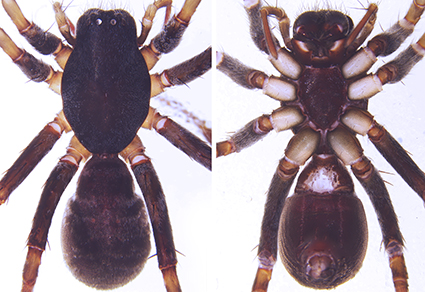Abstract
Two new Corinnomma species from Yunnan, China are described and illustrated in detail: Corinnomma simplex sp. nov. and C. spiralis sp. nov.. A redescription of C. severum is provided and the molecular results of the two new species are presented: C. simplex sp. nov. with a genetic distance of 0.000 and C. spiralis sp. nov. with 0.001.
References
Álvarez-Padilla, F. & Hormiga, G. (2007) A protocol for digesting internal soft tissues and mounting spiders for scanning electron microscopy. Journal of Arachnology, 35, 538–542. https://doi.org/10.1636/Sh06-55.1
Barrion, A.T., Barrion-Dupo, A.L.A., Catindig, J.L.A., Villareal M., O., Cai, D., Yuan, Q.H. & Heong, K.L. (2013) New species of spiders (Araneae) from Hainan Island, China. UPLB Museum Publications in Natural History, 3, 1–103.
Colgan, D.J., McLauchlan, A., Wilson, G.D.F., Livingston, S.P., Edgecombe, G.D., Macaranas, J., Cassis, G. & Gray, M.R. (1998) Histone H3 and U2 snRNA DNA sequences and arthropod molecular evolution. Australian Journal of Zoology, 46, 419–437.
https://doi.org/10.1071/ZO98048
Cushing, P.E. (2012) Spider-Ant Associations: an updated review of myrmecomorphy, myrmecophily, and myrmecophagy in spiders. Psyche, 2012, 1–23. https://doi.org/10.1155/2012/151989
Deeleman-Reinhold, C.L. (2001) Forest spiders of South East Asia: with a revision of the sac and ground spiders (Araneae: Clubionidae, Corinnidae, Liocranidae, Gnaphosidae, Prodidomidae and Trochanterriidae). Brill, Leiden, 591 pp. https://doi.org/10.1163/9789004475588
Hedin, M.C. (2001) Molecular insights into species phylogeny, biogeography, and morphological stasis in the ancient spider genus Hypochilus (Araneae: Hypochilidae). Molecular Phylogenetics and Evolution, 18, 238–251. https://doi.org/10.1006/mpev.2000.0882
Hedin, M.C. & Maddison, W.P. (2001) A combined molecular approach to phylogeny of the jumping spider subfamily Dendryphantinae (Araneae: Salticidae). Molecular Phylogenetics and Evolution, 18, 386–403. https://doi.org/10.1006/mpev.2000.0883
Haddad, C.R. (2006) A new species of Corinnomma (Araneae: Corinnidae) from southern and eastern Africa, with taxonomic notes on C. olivaceum and C. semiglabrum. African Invertebrates, 47, 71–83.
Jin, C. & Zhang, F. (2020) Spinirta gen. nov., a new dark sac spider genus from southern China (Araneae: Corinnidae). Zootaxa, 4838 (3), 301–330. https://doi.org/10.11646/zootaxa.4838.3.1
Karsch, F. (1880) Arachnologische Blätter (Decas I). Zeitschrift für die Gesammten Naturwissenschaften, Dritte Folge, 5, 373–409.
Köcher, T.D., Thomas, W.K., Meyer, A., Edwards, S.V., Paabo, S., Villablanca, F. & Wilson, A.C. (1989) Dynamics of mitochondrial DNA evolution in animals: amplification and sequencing with conserved primers. Proceedings of the National Academy of Sciences of the USA, 86, 6196–6200. https://doi.org/10.1073/pnas.86.16.6196
Katoh, K. & Standley, D.M. (2013) MAFFT multiple sequence alignment software version 7: improvements in performance and usability. Molecular Biology and Evolution, 30, 772–780. https://doi.org/10.1093/molbev/mst010
Kumar, S., Stecher, G., Li, M., Knyaz, C. & Tamura, K. (2018) MEGA X: Molecular Evolutionary Genetics Analysis across Computing Platforms, Molecular Biology and Evolution, 35, 1547–1549. https://doi.org/10.1093/molbev/msy096
Lanfear, R., Frandsen, P.B., Wright, A.M., Senfeld, T. & Calcott, B. (2017) PartitionFinder 2: new methods for selecting partitioned models of evolution formolecular and morphological phylogenetic analyses. Molecular Biology and Evolution, 34, 772–773. https://doi.org/10.1093/molbev/msw260
Ramírez, M.J. (2014) The morphology and phylogeny of dionychan spiders (Araneae: Araneomorphae). Bulletin of the American Museum of Natural History, 390, 1–374.
https://doi.org/10.1206/821.1
Raven, R.J. (2015) A revision of ant-mimicking spiders of the family Corinnidae (Araneae) in the Western Pacific. Zootaxa, 3958 (1), 1–258. https://doi.org/10.11646/zootaxa.3958.1.1
Rambaut, A., Drummond, A.J., Xie, D., Baele, G. & Suchard, M.A. (2018) Posterior summarisation in Bayesian phylogenetics using Tracer 1.7. Systematic Biology, 67, 901–904. https://doi.org/10.1093/sysbio/syy032
Reiskind, J. (1969) The spider subfamily Castianeirinae of North and Central America (Araneae: Clubionidae). Harvard University Cambridge, Massachusetts, U.S.A., 138, 1–325.
Ronquist, F., Teslenko, M., van der Mark, P., Ayres, D.L., Darling, A., Höhna, S., Larget, B., Liu, L., Suchard, M.A. & Huelsenbeck, J.P. (2012) MrBayes 3.2: efficient Bayesian phylogenetic inference and model choice across a large model space. Systematic. Biology, 61, 539–542. https://doi.org/10.1093/sysbio/sys029
Simon, E. (1886) Arachnides recueillis par M. A. Pavie (sous chef du service des postes au Cambodge) dans le royaume de Siam, au Cambodge et en Cochinchine. Actes de la Société Linnéenne de Bordeaux, 40, 137–166.
Simon, C., Frati, F., Beckenbach, A., Crespi, B., Liu, H. & Flook, P. (1994) Evolution, weighting, and phylogenetic utility of mitochondrial genesequences and a compilation of conserved polymerase chain reactionprimers. Annals of the Entomological Society of America, 87, 651–701. https://doi.org/10.1093/aesa/87.6.651
Thorell, T. (1877) Studi sui Ragni Malesi e Papuani. I. Ragni di Selebes raccolti nel 1874 dal Dott. O. Beccari. Annali del Museo Civico di Storia Naturale di Genova, 10, 341–637.
Tikader, B.K. & Biswas, B. (1981) Spider fauna of Calcutta and vicinity: Part-I. Records of the Zoological Survey of India, Occasional Paper, 30, 1–149.
Talavera, G. & Castresana, J. (2007) Improvement of phylogenies after removing divergent and ambiguously aligned blocks from protein sequence alignments. Systematic Biology, 56, 564–577. https://doi.org/10.1080/10635150701472164
World Spider Catalog (2022) World Spider Catalog. Version 23.0. Natural History Museum Bern. Available from: http://wsc. nmbe.ch (accessed 30 May 2022)
Zhang, D., Gao, F., Jakovlić, I., Zou, H., Zhang, J., Li, W.X. & Wang, G.T. (2020) PhyloSuite: An integrated and scalable desktop platform for streamlined molecular sequence data management and evolutionary phylogenetics studies. Molecular Ecology Resources, 20, 348–355. https://doi.org/10.1111/1755-0998.13096


